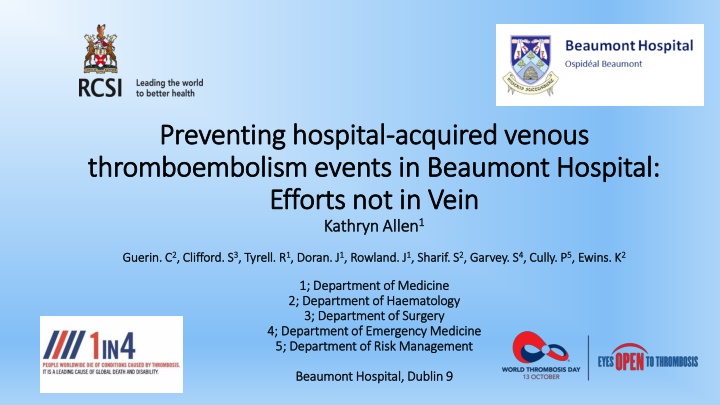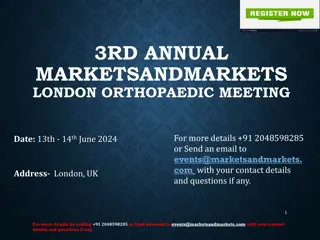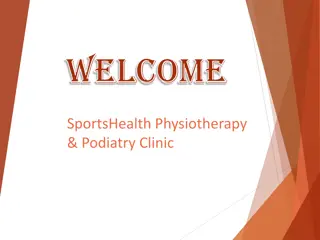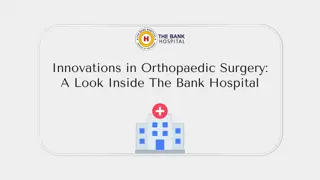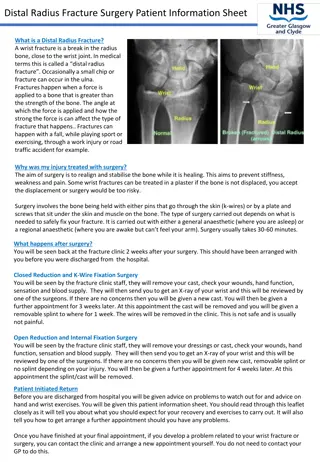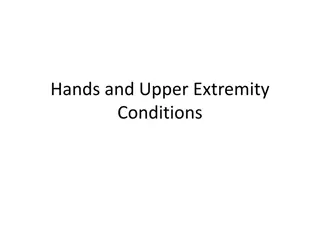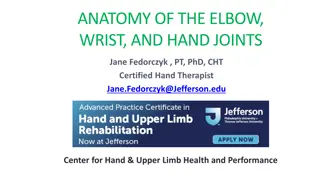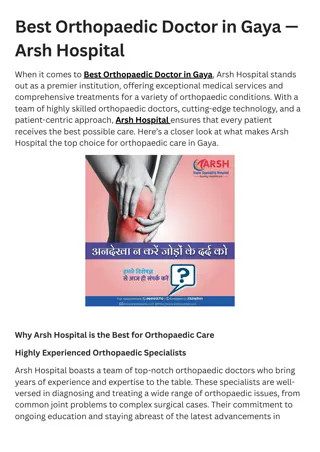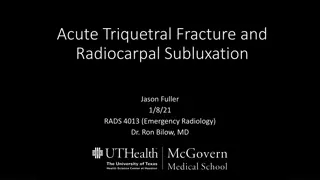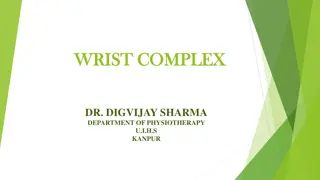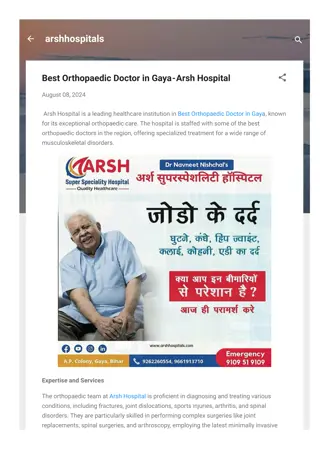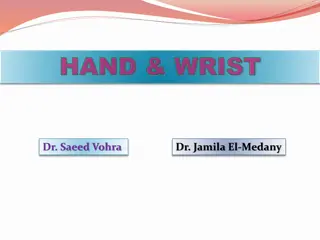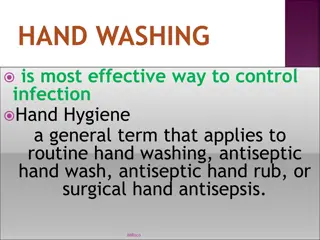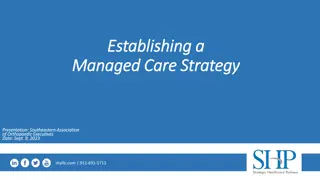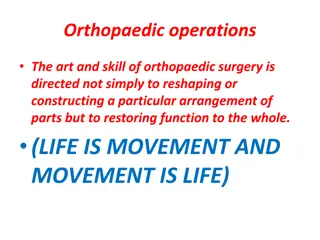GP Orthopaedic Lecture Series - Common Hand and Wrist Conditions
This Orthopaedic Lecture Series covers a range of common musculoskeletal conditions, with a focus on hand and wrist issues. Renowned speakers will delve into topics such as shoulder and elbow conditions, musculoskeletal triage, hip and knee pathologies, sports injuries, foot and ankle problems, and more. To register your interest in these informative webinars, contact orthogpwebinars@gmail.com. Stay updated by following their social media page on Facebook. Don't miss the opportunity to enhance your knowledge in orthopaedics.
Download Presentation

Please find below an Image/Link to download the presentation.
The content on the website is provided AS IS for your information and personal use only. It may not be sold, licensed, or shared on other websites without obtaining consent from the author.If you encounter any issues during the download, it is possible that the publisher has removed the file from their server.
You are allowed to download the files provided on this website for personal or commercial use, subject to the condition that they are used lawfully. All files are the property of their respective owners.
The content on the website is provided AS IS for your information and personal use only. It may not be sold, licensed, or shared on other websites without obtaining consent from the author.
E N D
Presentation Transcript
Preventing hospital Preventing hospital- -acquired venous thromboembolism events in Beaumont Hospital: thromboembolism events in Beaumont Hospital: Efforts not in Vein Efforts not in Vein Kathryn Allen Kathryn Allen1 1 acquired venous Guerin. C Guerin. C2 2, Clifford. S , Clifford. S3 3, Tyrell. R , Tyrell. R1 1, Doran. J , Doran. J1 1, Rowland. J , Rowland. J1 1, Sharif. S , Sharif. S2 2, Garvey. S , Garvey. S4 4, Cully. P , Cully. P5 5, Ewins. K , Ewins. K2 2 1; Department of Medicine 1; Department of Medicine 2; Department of Haematology 2; Department of Haematology 3; Department of Surgery 3; Department of Surgery 4; Department of Emergency Medicine 4; Department of Emergency Medicine 5; Department of Risk Management 5; Department of Risk Management Beaumont Hospital, Dublin 9 Beaumont Hospital, Dublin 9
Background Methods Hospital associated venous thromboembolism (HA-VTE) is a leading cause of preventable morbidity and mortality Up to 2/3 of HA-VTE cases are preventable with VTE risk assessment (VTE-RA) and appropriate thromboprophylaxis. Beaumont hospital has a rate of 3.03 cases of HA-VTE per 1000 inpatient discharges; this is higher than the average rate for all Model 4 hospitals in Ireland (2.45) The Beaumont Hospital Thrombosis Committee was set up in 2021 with a primary focus to increase the rate of VTE-RA and reduce the rate of HA-VTE We report the impact of a continuous quality improvement project on adherence with VTE prophylaxis guidelines, and the subsequent incidence of hospital-acquired VTE in all inpatients We performed a retrospective chart review of all hospital acquired VTE cases in Beaumont Hospital between July and December 2020 Cases were identified by extracting HIPE data by the same criteria used for the national key performance indicator (KPI) Data were collected on whether patients received VTE thromboprophylaxis, whether a VTE risk assessment (VTE- RA) was performed on admission, and whether mechanical thromboprophylaxis was initiated where appropriate In addition, we performed a monthly report on a random sample of hospital inpatients from June 2021 to January 2021, with rates of completion of VTE-RA on admission and rate of prescription of VTE prophylaxis calculated. Aim; To produce a monthly report of two quantitative assessments in Beaumont Hospital; Rate of completion of VTE-RA and rate of prescription of VTE prophylaxis The audit cycle is repeated on a monthly basis in conjunction with interventions Aim to increase VTE-RA compliance rates and thus lower the risk of HA- VTE in BH 9% of hospital deaths 0.4-3.8% of public hospital budgets in Europe (OECD) 70% preventable by prophylaxis (Geerts et al 2001 & 2004)
Results Results A list of 345 inpatients were randomly generated across medical and surgical specialities each month between June 2021 and February 2022. 2.8% (n=10) of these had a VTE-RA performed on admission 57% (n=195) had low molecular weight heparin (LMWH) prescribed 19% (n=65) had alternative anticoagulation prescribed 16% (n=57) had TEDs documented 14% (n=49) had no VTE-RA documented or anticoagulation prescribed In the third and fourth quarter of 2020 (July 1st-December 2020), 27 cases of HA-VTE were identified 21 were included for analysis 81% (n=17) patients had pulmonary embolus, and 19% (n=4) had deep venous thrombus Only 1 patient had formal VTE assessment on admission 14% (n=3) patients were deemed to have had a preventable VTE 33% (n=9) developed HA-VTE despite appropriate pharmacological prophylaxis 33% (n=9) had contraindication to pharmacological prophylaxis The most common listed reason for contraindication to thromboprophylaxis was recent intracranial haemorrhage (19% n=4) and thrombocytopaenia (14%, n=3) Key outcomes 3 of the HA- VTE in Q3/Q4 2020 were potentially preventable Overall rate of VTE-RA is poor in Beaumont Hospital No VTE-RA is associated with lack of appropriate anticoagulation No VTE-RA is associated with potential development of VTE VTE-RA performed on admission What worked well VTE-RA improved to 7.5% in October 2021 from 2% post a targeted education for world thrombosis day and the introduction of a new VTE-RA tool Rate of HA-VTE per 1,000 dropped to 1.69 post establishment of Thrombosis Committee in Q2 2021 Yes No
The Thrombosis Committee has introduced a new VTE-RA proforma into drug Kardex's in Beaumont Hospital Targeted NCHD/Nursing education campaigns are ongoing A multifaceted VTE prophylaxis quality improvement intervention, that combines regular education, distribution of a decision support tool and regular audit and feedback is ongoing at our institution The audit cycle will be repeated on a monthly basis in conjunction with this intervention We will reaudit incidence of HA-VTE post establishment of the Thrombosis Committee in Q3-Q4 2021 later this year Value to patients Hospitalization for an acute medical illness = 8 x VTE risk 1 in 3 VTE- related deaths occur post surgery HA-VTE is the most common cause of preventable death in hospital Surgical patients with cancer have 2- 3 x increased risk VTE vs general population There has been a 20% reduction in post-discharge VTE deaths in the UK since VTE-RA was made mandatory over 10 years ago VTE 4-6 x more common in those with cancer vs the general population Impact of MANDATORY use of VTE/bleeding risk assessment tool and targeted thromboprophylaxis for all admitted patients (95% compliance)
